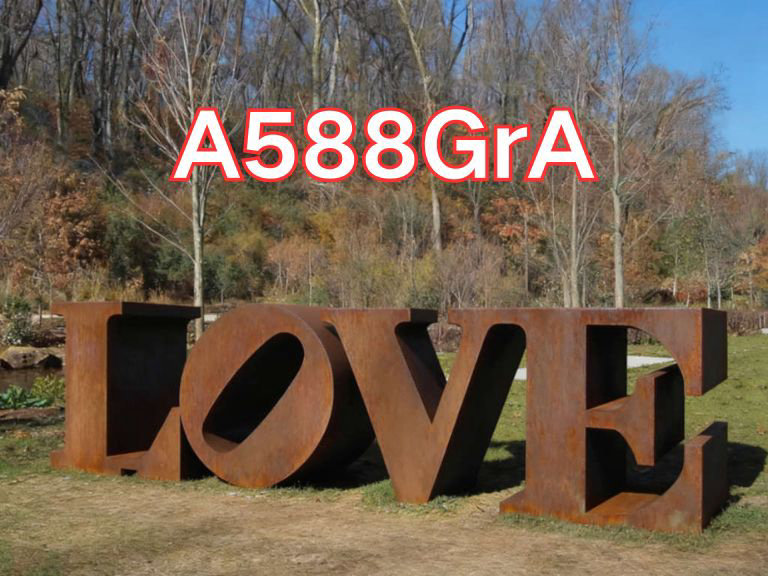

A588GrA
A588 Gr.A is a high-strength, low-alloy weathering structural steel plate, with its designation conforming to the American Society for Testing and Materials (ASTM) standard ASTM A588/A588M. The latest version of this standard is ASTM A588/A588M-23 "Standard Specification for High-Strength Low-Alloy Structural Steel with 50 ksi [345 MPa] Minimum Yield Point and Improved Atmospheric Corrosion Resistance". This is one of the most widely used weathering steel standards in North America, specifically designed for structural applications requiring high strength and excellent corrosion resistance.
The designation "A588 Gr.A" has a clear meaning:
"A588" refers to the ASTM standard number it follows.
"Gr" is an abbreviation for "Grade."
"A" represents the first quality grade under this standard, i.e., Grade A. According to the standard, Grade A steel requires a Charpy V-notch impact test at 20°F (-6.7°C), with the average absorbed energy (KV2) not less than 47 J.
The primary application of A588 Gr.A steel plate is in the fabrication of various load-bearing and non-load-bearing structures that are permanently exposed to the atmosphere. Its core advantage lies in combining high strength with exceptional weathering performance, making it ideal for projects that require reduced maintenance costs and extended service life. Typical applications include:
Bridge Engineering: Widely used in main girders, bridge decks, and trusses for highway and railway bridges—key structural components—and is a common material in North American bridge construction.
Architecture: Used for exposed structural steel in high-rise buildings, building façade cladding, art sculptures, and landscape features. Its naturally formed reddish-brown rust patina offers a unique industrial aesthetic.
Transportation: Used in the manufacture of containers, truck bodies, traffic signal towers, and noise barriers.
Industrial Facilities: Used in transmission towers, substation frameworks, storage silos, and pipe supports for outdoor installations.
Its main characteristics include:
High Strength: The specified minimum yield strength is 50 ksi (345 MPa), with tensile strength ranging from 70–90 ksi (485–620 MPa), providing excellent load-bearing capacity.
Superior Atmospheric Corrosion Resistance: By adding alloying elements such as copper (Cu), chromium (Cr), nickel (Ni), and phosphorus (P), the steel forms a dense, stable, and well-adhered protective rust layer in the atmosphere. This layer effectively prevents further intrusion of corrosive agents, giving it corrosion resistance far superior to ordinary carbon steel. When used unpainted, it can significantly extend the structure's service life.
Good Weldability and Workability: Despite its high strength, its chemical composition is optimized to ensure good weldability, suitable for various welding processes.
Cost-effectiveness and Environmental Friendliness: The ability to be used without paint significantly reduces lifecycle maintenance costs and environmental pollution.

Ultrasonic Testing (UT)
A key non-destructive testing technique that uses high-frequency sound waves to detect internal flaws in steel plates. The probe emits sound waves, which reflect when encountering defects such as cracks or inclusions. The receiver captures the echoes, enabling precise determination of defect location and size. With high sensitivity, strong penetration, and fast inspection speed, UT effectively ensures internal quality, widely used in the production of heavy plates, pressure vessel plates, and other high-end products to guarantee safety and reliability.

Magnetic Particle Testing (MT)
A common surface inspection method that magnetizes the workpiece, causing leakage magnetic fields at surface or near-surface defects like cracks or inclusions, which attract magnetic particles to form visible indications. Simple to operate and highly sensitive, MT is suitable for rapid inspection of surface and near-surface flaws in ferromagnetic materials, widely used for online or offline inspection of plate edges, ends, and welds, ensuring product quality and safety.

Penetrant Testing (PT)
A non-destructive method for detecting surface-breaking flaws. A penetrant liquid is applied to the cleaned steel surface, allowing it to seep into defects such as cracks or pores. After removing excess penetrant, a developer is applied, causing the trapped penetrant to bleed out and form visible indications. Simple and cost-effective, PT is suitable for inspecting surface defects in various non-porous materials, commonly used for welds, castings, and complex components, effectively ensuring surface quality of steel plates.










